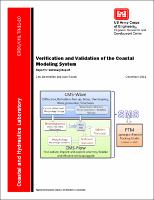Please use this identifier to cite or link to this item:
https://hdl.handle.net/11681/7660| Title: | Verification and validation of the coastal modeling system; Report 1: summary report |
| Authors: | Demirbilek, Zeki Rosati, Julie Dean |
| Keywords: | Data Errors Field and laboratory tests Numerical models Simulations Statistics Verification and validation Coastal Inlets Research Program (U.S.) |
| Publisher: | Engineer Research and Development Center (U.S.) |
| Series/Report no.: | Technical report (Engineer Research and Development Center (U.S.)) ; no.ERDC/CHL TR-11-10 rept.1 |
| Abstract: | This report summarizes the framework and provides key findings of the Verification and Validation (V&V) study for the Coastal Modeling System (CMS), a product of the Coastal Inlets Research Program (CIRP). There are three components of the study: Verification, Calibration, and Validation, and these are termed for simplicity as “V&V” herein and in the companion reports. This is the first report, Report 1, in a series of four reports, and it provides a synopsis of the major findings from the other three reports. Verification & Validation was performed for three main components of the CMS: CMS-Wave (Report 2), CMS-Flow (Report 3) and Sediment Transport and Morphology Change (Report 4). This Summary is intended for engineers and scientists considering whether the CMS would be appropriate for their projects, (after which they may study the other V&V reports), and for managers and decision-makers so that they will have a succinct resource detailing the performance of each CMS component as well as the integrated modeling system. The overall V&V study was separated into three functional areas to assess the predictive skills of the CMS critically; specifically, for modeling waves, circulation, and sediment transport and morphodynamics for a wide variety of coastal inlet, navigation channel, bay, estuary, and adjacent beach problems. To achieve this goal, each evaluation began by verification of the model of focus by comparing its predictions to analytical or empirical solutions for purposes of testing the basic physics and computational algorithms implemented in a given model. These fundamental evaluations were followed by a set of applications with data available either from laboratory or field investigations, which were used to validate the models. The validation cases represent real world problems, typical applications for which CMS is applied within the coastal navigation mission area. For the Hydrodynamics Flow, and Sediment Transport and Morphology Change applications, the CMS suite of models were calibrated prior to validation using data from a number of past and present District project applications with measured data. |
| Description: | Technical Report |
| Gov't Doc #: | ERDC/CHL TR-11-10 rept.1 |
| Rights: | Approved for public release; distribution is unlimited |
| URI: | http://hdl.handle.net/11681/7660 |
| Appears in Collections: | Technical Report Technical Report |
Files in This Item:
| File | Description | Size | Format | |
|---|---|---|---|---|
| CHL-TR-11-10-Rpt-1.pdf | ERDC/CHL TR-11-10 rept.1 | 991.7 kB | Adobe PDF |  View/Open |